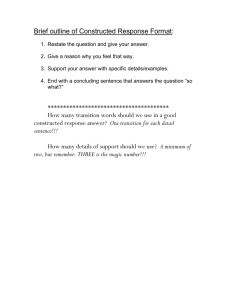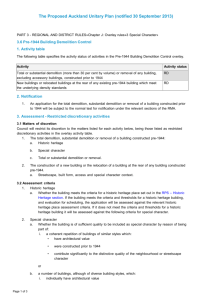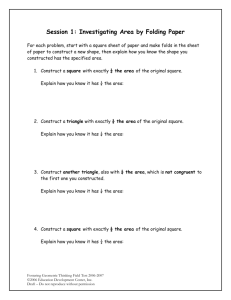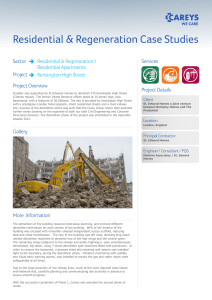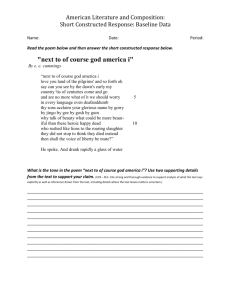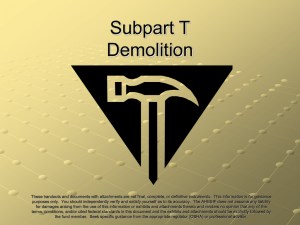Traditional building character (demolition
advertisement
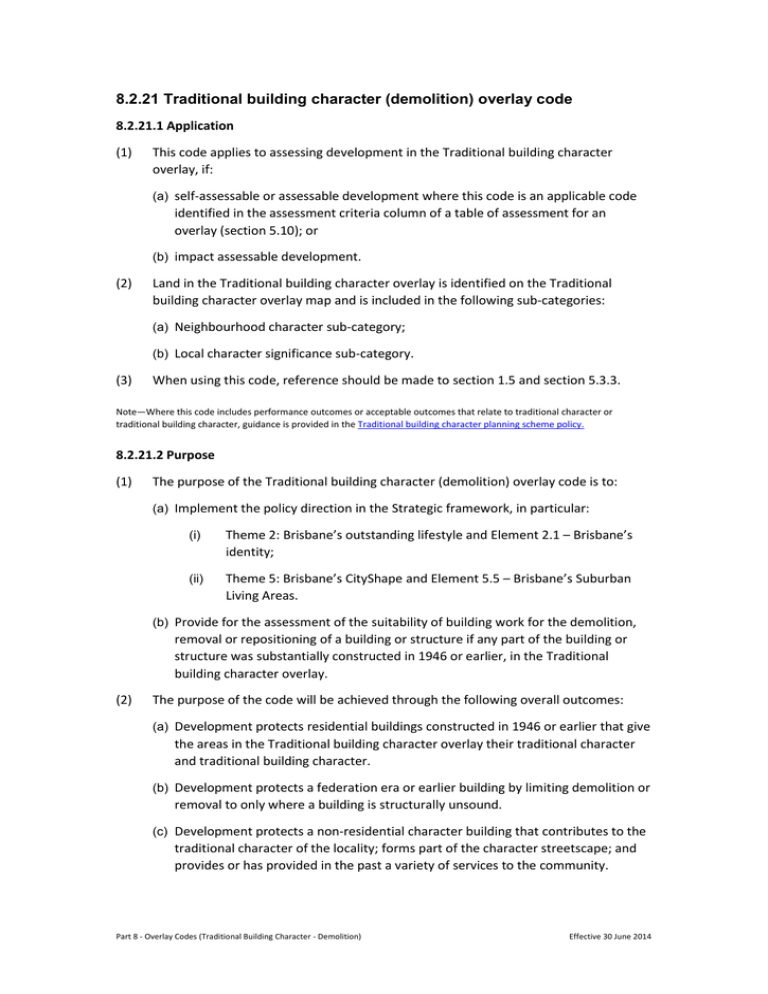
8.2.21 Traditional building character (demolition) overlay code 8.2.21.1 Application (1) This code applies to assessing development in the Traditional building character overlay, if: (a) self-assessable or assessable development where this code is an applicable code identified in the assessment criteria column of a table of assessment for an overlay (section 5.10); or (b) impact assessable development. (2) Land in the Traditional building character overlay is identified on the Traditional building character overlay map and is included in the following sub-categories: (a) Neighbourhood character sub-category; (b) Local character significance sub-category. (3) When using this code, reference should be made to section 1.5 and section 5.3.3. Note—Where this code includes performance outcomes or acceptable outcomes that relate to traditional character or traditional building character, guidance is provided in the Traditional building character planning scheme policy. 8.2.21.2 Purpose (1) The purpose of the Traditional building character (demolition) overlay code is to: (a) Implement the policy direction in the Strategic framework, in particular: (i) Theme 2: Brisbane’s outstanding lifestyle and Element 2.1 – Brisbane’s identity; (ii) Theme 5: Brisbane’s CityShape and Element 5.5 – Brisbane’s Suburban Living Areas. (b) Provide for the assessment of the suitability of building work for the demolition, removal or repositioning of a building or structure if any part of the building or structure was substantially constructed in 1946 or earlier, in the Traditional building character overlay. (2) The purpose of the code will be achieved through the following overall outcomes: (a) Development protects residential buildings constructed in 1946 or earlier that give the areas in the Traditional building character overlay their traditional character and traditional building character. (b) Development protects a federation era or earlier building by limiting demolition or removal to only where a building is structurally unsound. (c) Development protects a non-residential character building that contributes to the traditional character of the locality; forms part of the character streetscape; and provides or has provided in the past a variety of services to the community. Part 8 - Overlay Codes (Traditional Building Character - Demolition) Effective 30 June 2014 (d) Development protects a building constructed in 1946 or earlier where it forms an important part of a streetscape established in 1946 or earlier. (e) Development retains a residential building constructed in 1946 or earlier that reflects the traditional building character other than ‘timber and tin’ architecture, if in the Character residential zone. (f) Development ensures that a dwelling house moved onto, or repositioned within a small lot is consistent with the requirements for houses on a small lot. (g) Development permits demolition or removal of post-1946 residential buildings or structurally unsound buildings. (h) Development ensures that, in conjunction with the Traditional building character (design) overlay code, precincts of residential buildings constructed in 1946 or earlier are retained and redevelopment in those precincts complements the traditional building character of buildings constructed in 1946 or earlier. 8.2.21.3 Assessment criteria The following table identifies the assessment criteria for self-assessable and assessable development. Table 8.2.21.3—Criteria for self-assessable and assessable development Performance outcomes Acceptable outcomes Section A—Partial demolition of a building constructed in 1946 or earlier General PO1 AO1.1 Development involving partial demolition of traditional elements, detailing and materials constructed in 1946 or earlier does not diminish traditional building form and roof styles, where: Development ensures that the building does not lose integral components such as feature roof forms and side verandahs, which contribute to its streetscape character. (a) forward of the primary ridge or primary gable roof form; or (b) on the side elevation of the building where on a corner lot. Note—Where demolition results in the loss of integral components, assessment against Section B of this code is also required. AO1.2 Development involving partial demolition does not result in a narrow building which has a width-to-height proportion out of character with dwelling houses constructed in 1946 or earlier in the streetscape. Additional criteria for a pre-1911 building PO2 AO2 Development ensures that the building does not lose integral components that contribute to its traditional building character. Development retains the parts of the building constructed in the federation era or earlier. Additional criteria if in the Sherwood—Graceville district neighbourhood plan area where not in the Westside character precinct Part 8 - Overlay Codes (Traditional Building Character - Demolition) Effective 30 June 2014 PO3 AO3.1 Development ensures that: Development retains the building in its original form, proportions and external components, including: (a) significant elements that contribute to the character of buildings constructed in 1946 or earlier are retained if they can be seen from the primary street frontage; (a) the front walls and the roof form and side walls beyond, at least as far back as the ridge of the rearmost gable in a gable roof house or the primary ridge for (b) the proposed partial demolition does not a hipped roof house; affect the view of the original structure from the street. (b) original doors and windows and their size, proportions and materials; Note—Elements include roof form, external walls, building core, verandahs, external openings and decorative detailing. (c) side and front verandahs including balustrading and decorative details. AO3.2 Development retains the front door to the house as the main entrance in its original location and proportion. Note—The extent of any partial demolition is to be identified in plan and elevation drawings. Additional criteria if in the Bulimba district neighbourhood plan area PO4 AO4 Development involving partial demolition or refurbishment of a dwelling house constructed in 1946 or earlier as part of refurbishment or extension work does not diminish the traditional building character elements of the building. Development complies with an engineering report prepared by a Registered Professional Engineer Queensland which certifies that all works proposed whether permanent or temporary will ensure the structural adequacy of the building at all phases of building work. Note—The extent of any partial demolition is to be identified in plan and elevation drawings. Section B—Demolition or removal of a building constructed in 1946 or earlier General criteria if not in the Latrobe and Given Terraces neighbourhood plan area PO5 AO5 Development involves a building which: Development involves a building which: (a) does not represent traditional building character; or (a) has been substantially altered or does not have the appearance of being constructed in 1946 or earlier; or (b) is not capable of structural repair; or (c) does not contribute positively to the visual character of the street. Part 8 - Overlay Codes (Traditional Building Character - Demolition) (b) an engineering report prepared by a Registered Professional Engineer Queensland which certifies that the building is structurally unsound and not reasonably capable of being made Effective 30 June 2014 structurally sound; or (c) if demolished will not result in the loss of traditional building character; or (d) is in a street that has no traditional character. Note— For the purpose of this code, comparative analysis of an existing dwelling constructed in 1946 or earlier against the current timber framing standards is not considered to demonstrate 'structurally unsound'. Additional criteria if a pre-1911 building PO6 AO6 Development involves a building which is not capable of structural repair. Development involves a building which a Registered Professional Engineer Queensland certifies is structurally unsound and not reasonably capable of being made structurally sound. Note— For the purpose of this code, comparative analysis of an existing dwelling constructed in 1946 or earlier against the current timber framing standards is not considered to demonstrate 'structurally unsound'. Additional criteria if in the Local character significance sub-category PO7 AO7.1 Development involves a building which: Development involves a building which has been substantially and irreversibly altered or does not have the appearance of being constructed in 1946 or earlier. (a) does not represent traditional building character; (b) is not capable of structural repair; (c) is not a building constructed in 1946 or earlier. AO7.2 Development involves a building which: (a) has an appearance that cannot practically be reinstated to that of a building constructed pre-1911 or in 1946 or earlier; or Note—In making a determination as to whether the appearance of a building constructed in 1946 or earlier can be reinstated, Council will require information to be submitted with any development application addressing the practicalities of a development: Part 8 - Overlay Codes (Traditional Building Character - Demolition) opening up enclosed front and/or side verandahs; removing enclosures under the front section of the building; removing fibro, stucco or metal cladding to underlying weatherboards or chamferboards replacing aluminium windows with timber Effective 30 June 2014 windows; reinstating verandah elements. (b) an engineering report prepared by a Registered Professional Engineer Queensland certifies is structurally unsound and not reasonably capable of being made structurally sound; or (c) is located in the Hawthorne centre precinct of the Bulimba district neighbourhood plan and is not a character non-residential building. Additional criteria if in the Latrobe and Given Terraces neighbourhood plan area PO8 AO8 Development involves a building which is not capable of being structurally repaired. Development involves a building which a Registered Professional Engineer Queensland certifies is structurally unsound and not reasonably capable of being made structurally sound. Note— For the purpose of this code, comparative analysis of an existing dwelling constructed in 1946 or earlier against the current timber framing standards is not considered to demonstrate 'structurally unsound'. Section C—Repositioning of a residential building or structure if any part of the building or structure was substantially constructed in 1946 or earlier PO9 AO9 Development involving the repositioning of a dwelling house that straddles more than one lot, onto one small lot: Development involving the repositioning of a dwelling house constructed in 1946 or earlier on a small lot results in setbacks that comply with the following acceptable outcomes of the Dwelling house (small lot) code: (a) does not detract from the traditional setting of the houses and traditional scale of the street; (b) does not impact on the amenity or privacy of adjoining residents; (a) AO2.4 side boundary setback; (b) AO2.5 rear boundary setback. (c) provides adequate open space, screening and noise attenuation from the street. Editor's note—Where not on a small lot, repositioning must not result in an unlawful structure regulated by the Building Act 1975. PO10 AO10.1 Development ensures that the siting and orientation of a residential building on a lot: (a) is complementary to the traditional setting of a dwelling house constructed in 1946 or earlier nearby in the street; Development involving a residential building remains orientated to face its existing street frontage in a manner consistent with a dwelling house constructed in 1946 or earlier on adjoining lots. (b) does not diminish the streetscape AO10.2 Part 8 - Overlay Codes (Traditional Building Character - Demolition) Effective 30 June 2014 character of the original street to which the building was orientated; (c) does not result in a the building being isolated from a traditional streetscape. Part 8 - Overlay Codes (Traditional Building Character - Demolition) Development retains the residential building within 20% of the front setback of a neighbouring dwelling house constructed in 1946 or earlier. Effective 30 June 2014
